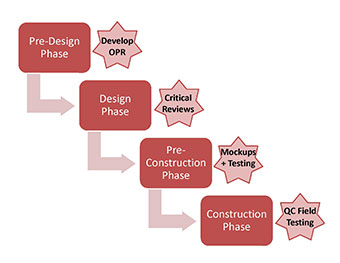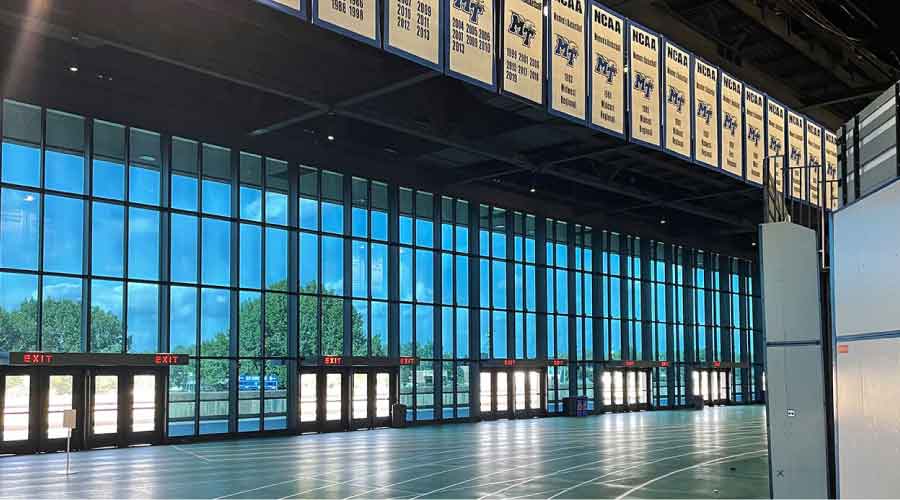Building Enclosure Commissioning During Pre-Design And Design Phases
A common theme in industry definitions of commissioning and building enclosure commissioning is the idea that these are processes. They are not intended to be a series of isolated activities or evaluations, but ongoing and continuous reviews and verifications to confirm that the owner’s project requirements are properly implemented and accounted for throughout the entire design and construction cycle. To truly be effective, building enclosure commissioning activities must begin in the pre-design phase, and continue through design, pre-construction, and construction phases of the project. The most critical and valuable activities in each of the phases are discussed below.
The Pre-Design Phase — Beginning the process during the pre-design phase sets the foundation for an effective process. A successful building enclosure commissioning process starts with a clear definition of the owner’s project requirements (OPR). The OPR is a written document that outlines all of the owner’s goals for the building enclosure, including consideration for energy, environment, safety, security, durability, sustainability, and operation. Developing a written OPR will confirm that the project team shares the same understanding of the project’s enclosure requirements and sets the stage for an efficient design process.
 It is important to establish the scope and budget for the building enclosure commissioning activities during the pre-design phase. The various building enclosure commissioning industry standards include many tasks through the process, but not all of these tasks may be necessary or desirable given the overall project scope, schedule, and budget. Both the ASTM standard for building enclosure commissioning and the current LEED requirements include two levels of building enclosure commissioning: fundamental commissioning and enhanced commissioning. The selected scope will depend on the owner’s preferred level of building quality, the level of risk the owner is willing to accept, and the building type, size, and complexity.
It is important to establish the scope and budget for the building enclosure commissioning activities during the pre-design phase. The various building enclosure commissioning industry standards include many tasks through the process, but not all of these tasks may be necessary or desirable given the overall project scope, schedule, and budget. Both the ASTM standard for building enclosure commissioning and the current LEED requirements include two levels of building enclosure commissioning: fundamental commissioning and enhanced commissioning. The selected scope will depend on the owner’s preferred level of building quality, the level of risk the owner is willing to accept, and the building type, size, and complexity.
Defining the building enclosure commissioning level and scope will allow the building enclosure commissioning authority to prepare a written plan for the project. This plan includes an overview of the commissioning process, defines the roles and responsibilities of the various project team members, outlines the various planned commissioning activities, and documents the expectations for communication during the commissioning process. Although the written plan may be revised several times during the project as requirements evolve, it is a valuable tool for keeping the project on track.
The Design Phase — Once the OPR and building enclosure commissioning plan are established during the pre-design phase, the project team moves forward with project design. The building enclosure commissioning authority reviews the design team’s work to verify that the basis of design aligns with the established OPR. The enclosure systems selected for the project must be able to meet the important criteria established by the owner. The building enclosure commissioning authority will report basis of design items that are incongruous with the OPR to the owner, so the owner can decide if they want to modify the OPR to accept the change or ask for adjustments in the basis of design.
Once the enclosure systems are selected and the project team begins the design, the building enclosure commissioning authority performs periodic peer reviews of the building enclosure design documents. The authority checks that the details and selected products align with the agreed-upon OPR and basis of design. Design reviews typically include mark-ups of the drawings and specifications, and development of an issues log. The issues log tracks all identified deviations of the design from the OPR. The process is not complete until each item in the issues log is resolved to the owner’s satisfaction. It is important for the owner to work closely with the authority during this process because it is the owner’s responsibility to enforce the authority’s recommendations with the project team. The project team maintains discretion over the design throughout the entire process. The authority does not have the ability to make changes to the design.
During the design phase, the building enclosure commissioning authority also helps the owner and project team develop appropriate performance assessment and testing requirements for the various enclosure systems. Performance assessment and testing typically include pre-construction laboratory mockups; field constructed off- and on-structure mockups, field testing at milestone intervals, and post-occupancy evaluation. The performance metrics relate directly to the established OPR. ASTM E2813 includes a nearly exhaustive list of possible performance testing options. The building enclosure commissioning authority documents these performance metrics and testing requirements by developing an enclosure commissioning specification for inclusion in the contract documents.
Related Topics:








 It is important to establish the scope and budget for the building enclosure commissioning activities during the pre-design phase. The various building enclosure commissioning industry standards include many tasks through the process, but not all of these tasks may be necessary or desirable given the overall project scope, schedule, and budget. Both the ASTM standard for building enclosure commissioning and the current LEED requirements include two levels of building enclosure commissioning: fundamental commissioning and enhanced commissioning. The selected scope will depend on the owner’s preferred level of building quality, the level of risk the owner is willing to accept, and the building type, size, and complexity.
It is important to establish the scope and budget for the building enclosure commissioning activities during the pre-design phase. The various building enclosure commissioning industry standards include many tasks through the process, but not all of these tasks may be necessary or desirable given the overall project scope, schedule, and budget. Both the ASTM standard for building enclosure commissioning and the current LEED requirements include two levels of building enclosure commissioning: fundamental commissioning and enhanced commissioning. The selected scope will depend on the owner’s preferred level of building quality, the level of risk the owner is willing to accept, and the building type, size, and complexity.




